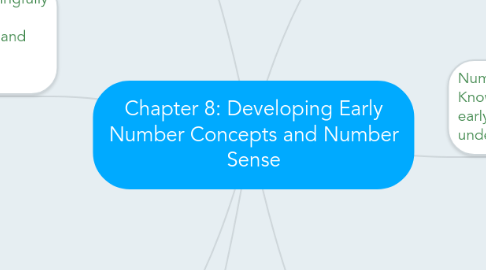
1. Early Number Sense: Number sense is the connection of real-life experiences to numbers, and using benchmarks and referents. A students numbers sense will continue to evolve over time as a by-product of learning, not direct instruction. Number sense includes, but is not limited to subtilizing, counting, and comparing quantities.
2. Relationships for Number 1 Through 10: One children meaningfully understand counting, they should be introduced to various number relationships. For example: one and two more, one and two less, benchmarks of 5 and 10, and part-part-whole relationships.
2.1. One and Two More, One and Two Less: When students relate numbers as "two more than" etc., they must realize that the quantity is two greater, as opposed just two counts after. This attaches the quantitative meaning to the comparison as opposed to only their places on a number line.
2.2. Anchoring Numbers to 5 and 10: It is important for students to relate number to each other, specifically 5 and 10. Younger students can begin this by representing numbers concretely on a 5 frame. Once students have experience with the 5 frame, then 10 from can be used. Students will develop anchoring skills through practice. Ten from tasks may be difficult because students must sue their working memory.
2.3. Part-Part-Whole Relationships: After students are able to count out quantities, they should be taught to understand number in parts.
2.3.1. Basic Ingredients of Part-Part-Whole Activities: When learning this strategy, students should start with small numbers, and focus on a single number for a long period of time. Students should read the parts aloud and write them down alongside completing various activities.
2.3.2. Part-Part-Whole Activities: Students can mentally or concretely build numbers out of parts, as well as reading the number sentences aloud.
2.3.3. Missing-Part Activities: These activities require students to know the whole amount, and uncover an unknown part. Students must have a base knowledge of part-part-whole activities to complete these tasks. missing-part activities are a precursor for subtraction.
2.4. Dot Cards as a Model for Teaching Number Relationships: Dot cards combine the number comparison techniques outlined so far. They help students practice flexible understanding and comparing numbers.
3. Relationships for Number 10 through 20: Understanding numbers 11-20 is equally as important as understanding number 0-10.
3.1. Early Place Value Concepts: The number words from 11-20 can seem arbitrary, so it is important to provide oral and visual support. Students should begin to see "teen" numbers as a ten plus a collection of ones.
3.2. Extending More-Then and Less-Then Relationships: More-than less-than relationships can also be applied to numbers 11-20.
4. Number Sense in Their World: Begin to teach number sense by using real-world, rich tasks.
4.1. Estimation and Measurement: To introduce estimation using measurement, begin by teaching simple comparisons.
4.2. Data Collection and Analysis: Using graphs can be a helpful way for students to compare numbers, and relates to activities in science.
4.3. Classroom Routines: Incorporate numbers into daily classroom routines. (Ex. Skip-counting, reversing number direction, number of the day)
5. Promoting Good Beginnings: Early childhood experiences in math impact future math abilities.
6. Number Concepts, Quantity, Counting, and Knowing How Many: Daily counting activities in early childhood contribute to emerging math understanding.
6.1. Quantity and the Ability to Subtilize: The ability to see and quickly recognize quantities is called subitizing. This should be practiced using basic shapes and symmetrical patterns.
6.2. Early Counting: Early counting follows a learning trajectory which outlines various levels of thinking. Children should develop verbal counting and attach meaningful quantities to each number.
6.2.1. The Development of Verbal Counting Skills: Learning the number words from one to ten can be difficult because the words are arbitrary. Once children begin to recognize a pattern in the higher numbers, counting becomes easier.
6.2.2. Meaning Attached to Counting Objects: Students may be able to count, but may still not understand that the last number said represents to total amount.
6.2.3. Thinking About Zero: The concept of zero is difficult to understand, so students must be intentionally taught what the number represents.
